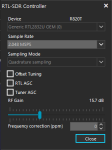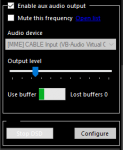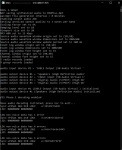Kindly request expert advice to optimize my decoding of local P25 voice comms. There was a brief moment where I had it perfectly intelligible, and something changed.... I have driven myself nuts tweaking DSD+ settings, VB cable settings, Windows sound settings, and SDRSharp settings (not to mention antenna fun) to try and get it going again. To be honest, in looking at the settings which still get me semi-intelligible speech, I don't even understand why those settings work at all (especially as they relate to VB cable settings). I have taken screenshots (attached, and via imgur link) to explain my current configuration.
In summary: I am running an RTL-SDR v3 (USB), tuned to a known voice channel in SDR#, through VB Cable to the DSD+ plug-in on SDR#, and then out through my computer speakers. I am the cheap dipole which came with the RTL-SDR, with the elements more or less the right size (target freq is ~861 MHz). SNR during broadcast is around 40 dB, so one would think I'm okay there. SDR gain in software is also set to roughly 14 dB. To troubleshoot, I recorded raw IQ files and played them back at various settings, and can't get it perfect even though I know its possible to do better. You can see in the screenshots that the DSD log is rife with errors. I also included some screenshots of Unitrunker on the control channel, in case it helps diagnose.
Anyway, welcome community advice to help optimize my P25 voice decoding. If this is simply RF being voodoo, I can accept it. If I have done something stupid with sound settings, VB settings, or all the various sampling settings, I'd love to take this opportunity to learn. Thank you in advance.
Screenshots of SDR#, DSD+ VBCable, and Windows 10 settings, and bonus Unitrunker snips:
Raw baseband IQ data available upon request (large file).
Thank you!
In summary: I am running an RTL-SDR v3 (USB), tuned to a known voice channel in SDR#, through VB Cable to the DSD+ plug-in on SDR#, and then out through my computer speakers. I am the cheap dipole which came with the RTL-SDR, with the elements more or less the right size (target freq is ~861 MHz). SNR during broadcast is around 40 dB, so one would think I'm okay there. SDR gain in software is also set to roughly 14 dB. To troubleshoot, I recorded raw IQ files and played them back at various settings, and can't get it perfect even though I know its possible to do better. You can see in the screenshots that the DSD log is rife with errors. I also included some screenshots of Unitrunker on the control channel, in case it helps diagnose.
Anyway, welcome community advice to help optimize my P25 voice decoding. If this is simply RF being voodoo, I can accept it. If I have done something stupid with sound settings, VB settings, or all the various sampling settings, I'd love to take this opportunity to learn. Thank you in advance.
Screenshots of SDR#, DSD+ VBCable, and Windows 10 settings, and bonus Unitrunker snips:
Raw baseband IQ data available upon request (large file).
Thank you!
Attachments
-
 0Capture.PNG300.2 KB · Views: 29
0Capture.PNG300.2 KB · Views: 29 -
 Capture.PNG16.5 KB · Views: 32
Capture.PNG16.5 KB · Views: 32 -
 Capture2.PNG8.9 KB · Views: 31
Capture2.PNG8.9 KB · Views: 31 -
 Capture3.PNG5.3 KB · Views: 31
Capture3.PNG5.3 KB · Views: 31 -
 Capture4.PNG19.3 KB · Views: 37
Capture4.PNG19.3 KB · Views: 37 -
 Capture7.PNG221.5 KB · Views: 36
Capture7.PNG221.5 KB · Views: 36 -
 Capture_collage.PNG351 KB · Views: 38
Capture_collage.PNG351 KB · Views: 38 -
 Capture16.PNG294.5 KB · Views: 30
Capture16.PNG294.5 KB · Views: 30 -
 Capture20.PNG156.2 KB · Views: 33
Capture20.PNG156.2 KB · Views: 33


